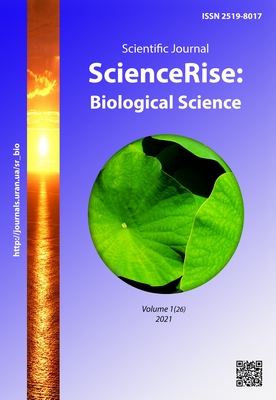Comparison of sperm parameters and testis histological structure in lake frog (Pelophylax ridibundus) from areas with different level of anthropogenic pollution
DOI:
https://doi.org/10.15587/2519-8025.2021.228082Keywords:
amphibians, sperm parameters, testes, histological changes, spermatogenesis, anthropogenic pollution, bioindicationAbstract
The aim. The aim of the work was to study the indicators of spermatogenesis in the lake frog, Pelophylax ridibundus (Pallas, 1771), in the zone of the influence of emissions from the Burshtyn Thermal Power Plant (TPP).
Materials and methods. Urinal sperm and testes samples were taken from male frogs under conditions of anthropogenic pollution (Burshtyn industrial area). Such parameters as sperm concentration in ejaculate, the number of live spermatozoa, total amount of actively mobile forms, and percentage of spermatozoa with progressive motion were determined by calculations in the hemocytometer. Testis samples were processed for routine histological method. The diameter of seminiferous tubules and histological abnormalities were studied.
Results. Studies have revealed that near the Burshtyn TPP industrial site, the sperm concentration in the sperm sample and the total number of motile spermatozoa of the lake frogs significantly decreased. The number of dead spermatozoa increases. Amphibians from polluted sites had histological abnormalities in testes such as dilation of the seminiferous tubules with sparse sperm. At the same time, the diameter of the seminiferous tubules in the animals from polluted site significantly decreased.
Conclusions. The impact of the emissions from the Burshtyn thermal power plant has an expressive reprotoxic effect that is manifested by depressive changes in testes tissue and gametes. The reproductive system of the lake frog is quite sensitive to environmental pollution. Sperm parameters and histological changes in testes are informative biomarkers and can be used for bioindication of technogenically transformed territories
References
- Mima, M., Greenwald, D., Ohlander, S. (2018). Environmental Toxins and Male Fertility. Current Urology Reports, 19 (7), 49–57. doi: http://doi.org/10.1007/s11934-018-0804-1
- Reznikov, A. G. (2014). The view of a pathophysiologist-endocrinologist on the problem of age-related androgen deficiency in men (LOH syndrome). International Journal of Endocrinology, 6 (62), 11–18.
- Pankivskyi, Y. I., Oshurkevych-Pankivska, O. Y., Ostashuk, M. B. (2017). Assessment of burshtyn TPP impact on ambient air. Scientific Bulletin of UNFU, 27 (5), 59–62. doi: http://doi.org/10.15421/40270512
- Koshlak, N. V. (2019). Environmental hazard of the technogenic soil pollution with heavy metals for the impact areas of Burshtyn TPP. Naukovo-tekhnichnyi zhurnal, 2 (20), 7–14.
- Yaglova, N. V., Yaglov, V. V. (2012). Endocrine disruptors are a novel direction of endocrinologic scientific investigation. Annals of the Russian Academy of Medical Sciences, 67 (3), 56–61. doi: http://doi.org/10.15690/vramn.v67i3.186
- Rehman, S., Usman, Z., Rehman, S., AlDraihem, M., Rehman, N., Rehman, I., Ahmad, G. (2018). Endocrine disrupting chemicals and impact on male reproductive health. Translational Andrology and Urology, 7 (3), 490–503. doi: http://doi.org/10.21037/tau.2018.05.17
- Filatova, L. N. (2011). Structure morfofunktsionalnoj of characteristic seed plant of the nimble lizard and lake frog in the zone of influence of the enterprises of ferrous meta. Vestnik OGU, 16 (135), 225–226.
- Cao, H., Shi, C., Jia, X. (2012). Toxicity mechanism of Cadmium-induced reactive oxygen species and protein oxidation in testes of the frog Rana nigromaculata. Acta Ecologica Sinica, 32 (13), 4199–4206. doi: http://doi.org/10.5846/stxb201106020739
- Larenas, J., Jaque, M., Bustos-López, C., Robles, C., Lobos, G., Mattar, C., Valdovinos, C. E. (2014). Histopathological findings in Gonads of Xenopus laevis from Central Chile. Gayana (Concepción), 78 (1), 70–73. doi: http://doi.org/10.4067/s0717-65382014000100009
- Zhang, H., Liu, W., Chen, B., He, J., Chen, F., Shan, X. et. al. (2018). Differences in reproductive toxicity of TBBPA and TCBPA exposure in male Rana nigromaculata. Environmental Pollution, 243, 394–403. doi: http://doi.org/10.1016/j.envpol.2018.08.086
- World Health Organization (2010). WHO laboratory manual for the examination and processing of human semen. Cambridge: Cambridge University Press, 4–33.
- Shevliuk, N. N., Blinova, E. E., Bokov, D. A., Demina, L. L. (2008). Morfofunktsionalnaia kharakteristika organov razmnozheniia gryzunov iz populiatsii, nakhodiaschikhsia v zone vliianiia zavoda, pererabatyvaiuschego gaz s povyshennym soderzhaniem soedinenii sery. Morfologiia, 5, 43–47.
- Pizent, A., Tariba, B., Zivkovic, T. (2012). Reproductive toxicity of metals in men. Archives of Industrial Hygiene and Toxicology, 63, 35–46. doi: http://doi.org/10.2478/10004-1254-63-2012-2151
- Aloyan, K. A., Matveyev, A. V., Morev, V. V., Korneyev, I. A. (2013). Physiology of sperm motility. Urologicheskie Vedomosti, 3 (4), 14–19. doi: http://doi.org/10.17816/uroved3414-19
- Moreno, R. D., Reyes, J. G., Farías, J. G., Parada-Bustamante, A., Aguirre, V., Zepeda, A. B. et. al. (2012). Spermatogenesis at the extreme: Oxidative stress as a converging mechanism of testicular damage due to pathological and environmental exposure. Testis: Anatomy, Physiology and Pathology. New York: Nova Science, 1–24.
Downloads
Published
How to Cite
Issue
Section
License
Copyright (c) 2021 Iryna Sluchyk, Bohdan Grytsulyak, Oksana Glodan, Iryna Ivasiuk, Alexandra Khallo

This work is licensed under a Creative Commons Attribution 4.0 International License.
Our journal abides by the Creative Commons CC BY copyright rights and permissions for open access journals.
Authors, who are published in this journal, agree to the following conditions:
1. The authors reserve the right to authorship of the work and pass the first publication right of this work to the journal under the terms of a Creative Commons CC BY, which allows others to freely distribute the published research with the obligatory reference to the authors of the original work and the first publication of the work in this journal.
2. The authors have the right to conclude separate supplement agreements that relate to non-exclusive work distribution in the form in which it has been published by the journal (for example, to upload the work to the online storage of the journal or publish it as part of a monograph), provided that the reference to the first publication of the work in this journal is included.









